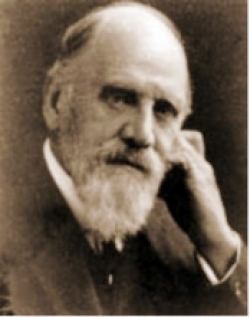Francis Darwin

- Born
- 16 August 1848
- Died
- 19 September 1925 (age 77)
Francis Darwin was a keen botanist who explored phototropism - how plants grow towards sunlight - with his father Charles Darwin. Their work led to the discovery of the important plant hormone auxin.
Francis Darwin was the seventh child born to Charles Darwin and Emma Darwin (née Wedgewood) in 1848. Darwin inherited his father’s passion for biology, and was described by his sister Henrietta Litchfield as “the only one of my father’s children to have a strong taste for natural history”. After a grammar school education in Clapham he was accepted into Trinity College, Cambridge University, where he initially studied mathematics.
However, Darwin soon changed his specialisation and graduated with a degree in Natural Sciences in 1870. During his time at Cambridge Darwin is said to have dissected a dead porpoise, sent to him by his brother, in his college bedroom. After his undergraduate degree, Darwin studied medicine at St George’s Medical School in London, and although he initially hoped to become a practising physician, “happily for me the Fates willed otherwise”. Upon being awarded a Bachelor of Medicine (MB) in 1875 Darwin moved back to his family home at Down House where his father took him on as secretary and assistant.
At Down House, Francis worked alongside his father to investigate plant physiology, in particular the factors that dictate the direction of plant growth. They used simple experiments to investigate touch and light sensitivity in grass seedlings. Their key finding was that light was detected by the tip of the plant, which causes bending in the seedling’s hypocotyl, or stem.
From this work Frances and Charles concluded that light sensed at the shoot tip causes a ‘messenger’ chemical to be transmitted down the stem to cause a response: these early studies formed the basis of research that led to the discovery of the growth hormone auxin. Charles Darwin published “The Power of Movement in Plants” in 1880, a landmark book for botanical studies in which the inscription reads “by Charles Darwin assisted by Francis Darwin”.
Francis Darwin also worked in the laboratory of the eminent plant physiologist Julius Sachs, in Würzburg from 1878 to 1879. These years contributed to his botanical studies with his father and, after Charles’ death in 1882, in his independent career. Elected a Fellow of the Royal Society in 1882, Darwin worked at Cambridge as a Lecturer of Botany and was later to become Reader. His research into tropism in plants, and plant water loss, led to prestige amongst fellow botanists and, among other honours, Francis Darwin was awarded the Royal Society's Darwin Medal in 1912. He was knighted a year later.
A kindly man known for his straightforward nature and love of dogs, Darwin suffered great personal tragedy. He married his first wife, Amy Ruck, in 1874; however, it was not long before she died in 1876 giving birth to their only son, Bernard Darwin. He remarried in 1883 to Ellen Wordsworth Crofts, who died in 1903 leaving one daughter Frances, with whom he was later buried. In 1913 he married for a third time to Lady Florence Henrietta Darwin.
As well as his remarkable scientific accomplishments, Francis Darwin is known for his contribution to literature. His famous work “Life and Letters of Charles Darwin” gave a poignant insight into the life of one of Biology’s greatest leaders. Francis died in 1925 and was buried near Cambridge with his daughter France Cornford.



